
© Foteini Christofilopoulou. (Click image for larger version)
Fabulous Beast Dance Theatre
The Rite of Spring, Petrushka
London, Sadler’s Wells
13 April 2013
Gallery of 30 Rite & Petrushka pictures by Foteini Christofilopoulou
www.fabulousbeast.net
www.sadlerswells.com
The vernal equinox having passed, here was my first sighting of The Rite of Spring in this the Centenary year of Stravinsky’s great masterpiece. There will be several more as we head towards, and beyond, the anniversary of the notorious, epoch-making first performance – at the Théâtre des Champs-Élysees – on 29 May 1913. Perversely, but perhaps in the spirit of Diaghilev, it was not a world premiere of a reimagining of that seminal ballet that this season at Sadler’s Wells celebrated, but of Michael Keegan-Dolan’s new interpretation of Petrushka.

© Foteini Christofilopoulou. (Click image for larger version)
The opening presentation of his choreography for The Rite of Spring is a significant revision of the work he made in collaboration with English National Opera in 2009. Hundreds of choreographers have attempted to channel the audacious tonal grandeur of the 33 minute score into movement since those first steps were inaugurated by Nijinsky. The music is both the great challenge and an enduring fascination for those who make dance. And, in this spirit, the great achievement of this particular production lies not in the choreography but in the decision to base both ballets on the piano transcriptions made for the original rehearsals. Keegan-Dolan’s decision to use the piano score struck me as ingenious, since here we were – six weeks or so ahead of the ballet’s Centenary – celebrating it with a performance made to the rehearsal transcription. Both works felt as if we were seeing them unfold in a rehearsal studio and, in this sense – whether intended or not – it appeared that Fabulous Beast were marking the Centenary of the creative process as much as that of the riotous first performance.
The sensitively nuanced finesse in the expressive pianism of the Serbian sisters, Lidija and Sanja Bizjak, was the evening’s tour de force. At the curtain call their youthfulness was accentuated by matching black dresses, white ankle-socks and flowing long hair but these two exceptional, experienced concert pianists are both now in their mid-thirties; and the mutual intuitive skills and technique of two siblings so close in age flows through the astounding reciprocity of their four hands on one piano. Reversing the chronological order of these ballets (Petrushka was premiered in 1911, but comes last on this programme) is essentially explained by this being their sequence on the Bizjak sisters’ highly acclaimed CD of these two works, released on the Mirare label in 2012. In passing, I highly recommend it.
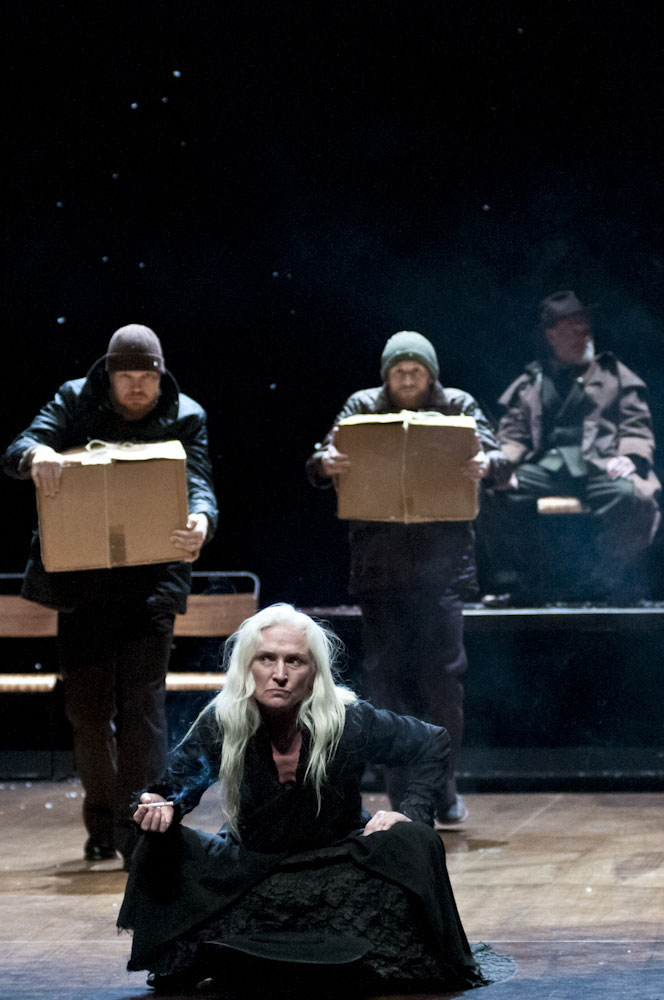
© Foteini Christofilopoulou. (Click image for larger version)
Keegan-Dolan’s choreography for The Rite of Spring has been given equal rights, since the original cast was 18 men and 3 women, while here it is a balanced mix of 6 from each gender. And where the 2009 iteration essentially stood on its own here the two works are reinvented as a double-header, almost as if two acts of the same production, an idea reinforced by the clarity of musical style and presentation. The same long white-haired mistress of ceremonies (Olwen Fouéré) presided over both events like a female Gandalf in black, but the white beard belonged to her sidekick, played by Bill Lengfelder who spent much of The Rite of Spring stretched out motionless on a table and virtually the whole of Petrushka seated under a lamp, atop of which Fouéré was balanced on a platform, a captive several metres off the ground until the last of the curtain calls had faded away! The risk assessments must have been interesting given that the performances also included serial cigarette smoking, the wielding of several knives and a solitary climb up a rope ladder without safety harness (albeit held tightly at the bottom by Lengfelder) right up into the flies as an allegorical ending to Petrushka, suggesting that the spirit of the dead clown is ascending to the heavens.
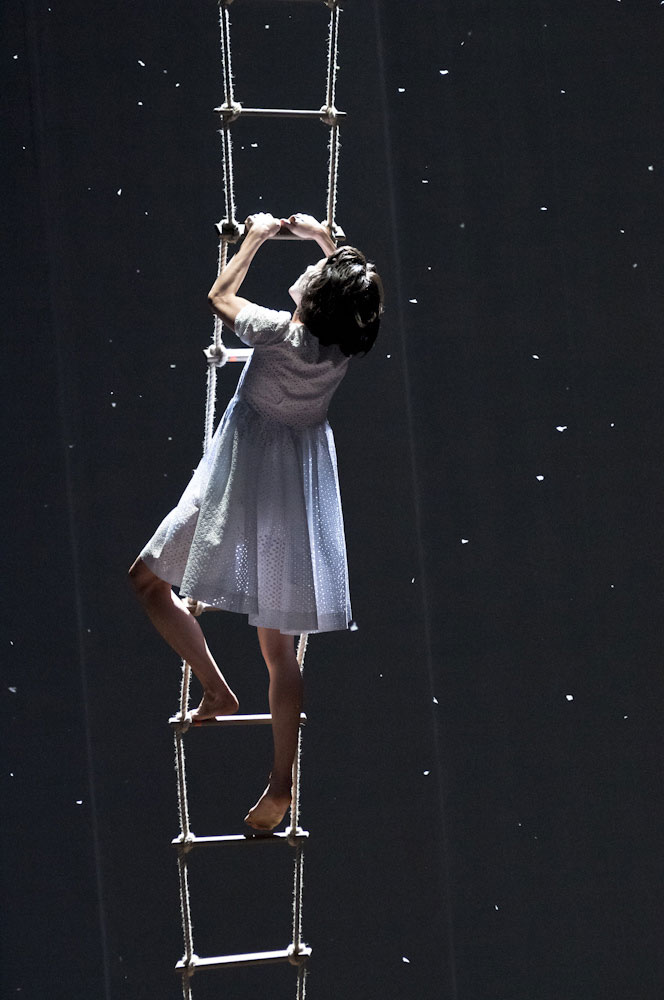
© Foteini Christofilopoulou. (Click image for larger version)
The action of Petrushka takes place at the Shrovetide fair in St Petersburg, a traditional Russian carnival prior to Lent, and The Rite of Spring is essentially about a pagan festival. This mutual sense of ritual celebration is another facet that joins the pair together into a seamless work of two halves. As The Rite of Spring progressed, I fancied a sense of this being some surreal spring fête, beginning with the members of the parish committee sitting at their desks (while the snow falls) carrying boxes of their contributions to the raffle, each dressed in an assortment of shirts, ties and tweeds that could have come from the wardrobe of the Parish Council in the Vicar of Dibley.
As the fête progressed we had some vile country “sport” with hare and hounds; a bizarre-bazaar bring-and-buy sale where the committee kindly donated all the clothes they were wearing, thankfully their nakedness was short-lived since the fête bunting turned into a string of twisted chintz dresses for everyone to wear (both men and women); and there was even a grotesque, post-modern dog show (with the male performers donning dog heads). In amongst these village frolics, communal tempers were regularly inflamed (perhaps angry that the flower arranging competition had again been fixed) and several dancers were set upon, in turn, as the outcome of this “pack” dynamic. The village elder (Lengfelder) – perhaps the Parish clerk – is one of the first of five to get beaten or ostracised. There is a sinister nastiness in the final dénouement for the “chosen one” as a woman stripped to bra and pants is surrounded by the pack, all now identically clothed in the floral dresses, knives in hand and with murderous intent as the curtain closes on Stravinsky’s final emphatic chord. Perhaps, on second thoughts, a fête that is not so much Vicar of Dibley as Midsomer Murders!
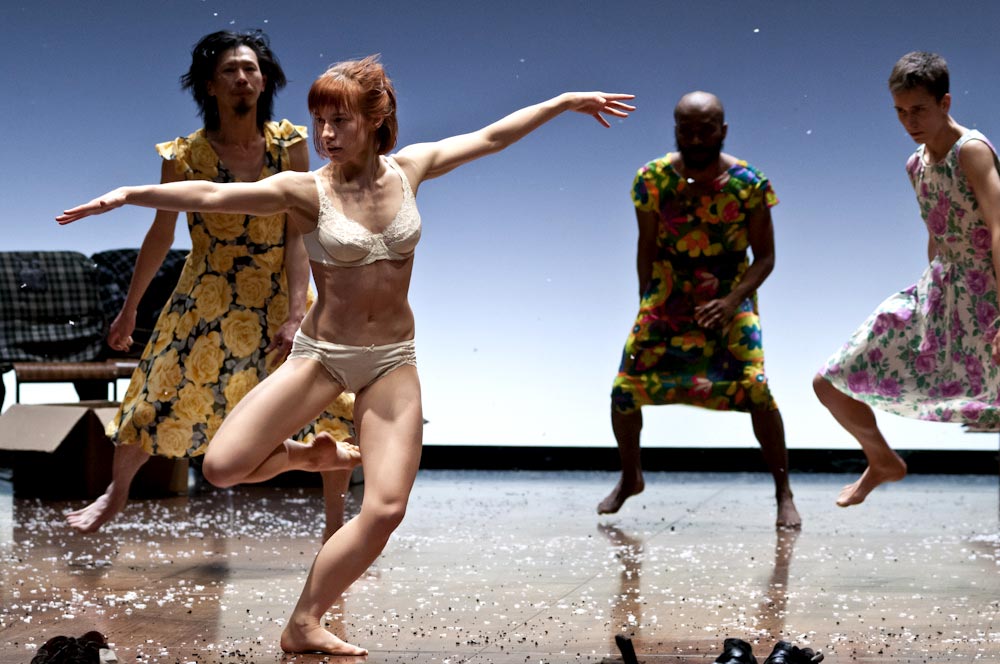
© Foteini Christofilopoulou. (Click image for larger version)
A great sense of theatre pervades this work, which is packed full of invention and visual references (perhaps too many for the viewer to assimilate simultaneously) but threaded through it all there is a coherent sense of musicality in the movement, which ranges from the delicate, sinuous body flow of Louise Mochia, to the powerful macho attack of the whole pack.
I liked the imagery and choreography of Petrushka far less overall and although the subtleties in how Keegan-Dolan flavours the work with an idea of the original narrative without imposing any of the characterisations is clever, you would need to have a reasonable knowledge of the original story to understand his intentions. For most spectators it will lose resonance without this familiarity. There is more ensemble dance – with less extraneous design to get in the way in what is essentially a white room – and this is consistently performed in tight unison by an excellent group although the choreographic motifs begin to feel very familiar, quite quickly into the action.
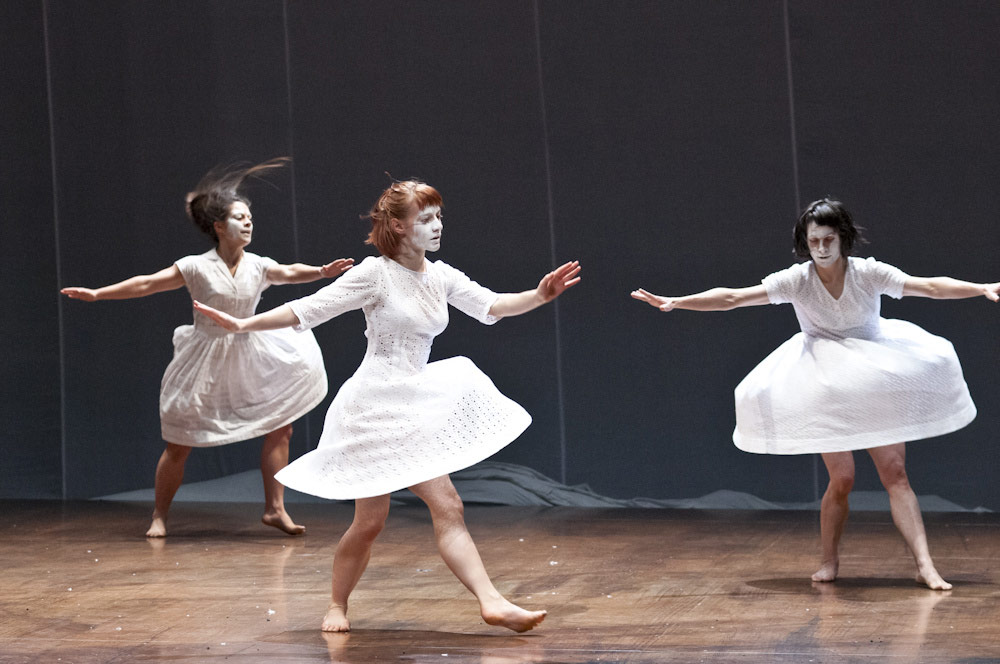
© Foteini Christofilopoulou. (Click image for larger version)
I started to see it, not as important dance in its own right or in terms of conveying the essence of the tale of the ill-fated puppet but just as visual bubbles of motion that illustrate the bustling exuberance and fairground burlesque in Stravinsky’s giddy, and ultimately melancholic score. Appropriately, it was the music channelled through the splendid performance of the Bizjak sisters that stole the show.













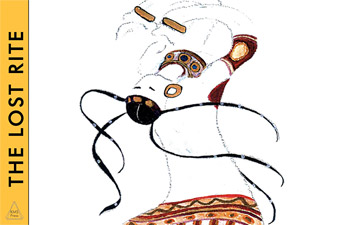



You must be logged in to post a comment.